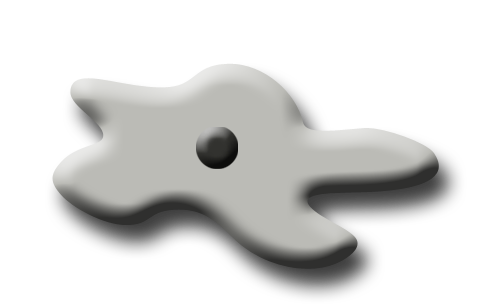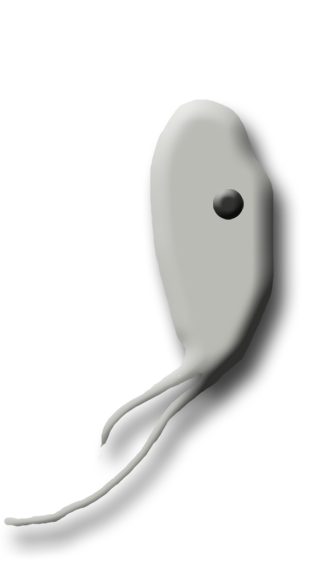Myxamöben - das sind kleine Einzeller, die aus den Schleimpilzsporen schlüpfen. Vergleichbar sind sie mit herkömmlichen Amöben: Sie bestehen aus einer Plasmamasse ohne feste Zellwand (nur mit dünner Zellmembran), besitzen einen Zellkern, in welchem die DNA auf einem haploiden Chromosomensatz liegt und bewegen sich auf feuchtem Untergrund unter ständiger Nahrungsaufnahme fort, wobei sich ihre Gestalt kontinuierlich ändert. Myxamoebae are small unicellular organisms that hatch from slime mold spores. They are similar to real amoebae: They consist of a mass of plasma without a solid cell wall (only a thin cell membrane), possess a nucleus that stores the DNA on a haploid chromosome set, and locomote on humid surfaces while continously taking in nutrition and changing their shape.

Wie - die bewegen sich?!
Ja! Aber sie sind ganz harmlos und ihre Bewegung ähnelt auch eher einem Fließen. Ihre Bewegung ist auch nur eine Folge ihrer ständigen Nahrungsaufnahme, denn Amöben können immer fressen und tun das folglich auch. Ihr Zellplasma verflüssigt sich zur Nahrungsaufnahme an einer bestimmten Stelle (auch genannt "Pseudopodien" oder "Scheinfüßchen") und kleine Nahrungspartikel werden somit umflossen, in einer Nahrungsvakuole eingeschlossen und verdaut. Dieses Prinzip der Phagozytose funktioniert auch umgekehrt und heißt dann Exozytose ¹.
What do you mean - they locomote?!
Yes! But they are absolutely harmless and their movement is similar to flowing. Their locomotion actually is just a result of their continuous intake of food, because amoebae can always eat and therefore do so. To take in food, their cell plasma liquifies in a specific spot (the so-called "Pseudopodia") and flows around small particles of food. The food is then enclosed within an alimentary vacuole and digested. This principle of phagocytosis also works the other way around and is then called exocytosis ¹.
Und was sind nun Myxoflagellaten?
Ist eine Myxamöbe von sehr viel Feuchtigkeit umgeben, kann sie sich in einen Myxoflagellaten verwandeln. Dieser Vorgang kann bei schwindender Feuchtigkeit auch rückwärts ablaufen und aus einem Myxoflagellaten entsteht wieder eine Myxamöbe. Der Myxoflagellat unterscheidet sich insofern von der Myxamöbe, dass er an einem Ende zwei Geißeln besitzt (ähnlich wie eine Bakterie, die jedoch nur eine Geißel ausbildet; Myxoflagellaten sind also biflagellat). Die lange Geißel dient der Vorwärtsbewegung, der Flagellat kann also schwimmen. Die kurze Geißel dient zusammen mit der langen Geißel der Nahrungsaufnahme: Kleine Nahrungspartikel wie Bakterien werden durch Strudeln in eine Vertiefung gedrängt und von einer Vakuole umschlossen².
And what are Myxoflagellates?
When a Myxamoeba is surrounded by a lot of moisture it can transform into a Myxoflagellate. This process can be reverted when the moisture is decreasing, transforming a Myxoflagellate back into a Myxamoeba. Other than a Myxamoeba, the Myxoflagellate possesses two whips or flagellates at its end (similar to bacteria, who only possess one whip however). The long whip serves the foward motion, meaning that the flagellate is able to swim. The shorter whip is used together with the longer one in order to take in food: small particles of food, such as bacteria, are rushed by a whirl into a dent, where they are enclosed in a vacuole².

Und was, wenn es ganz trocken wird?
Verschwindet jegliche Feuchtigkeit, können sich Myxamöben in kleine Mikrozysten verwandeln. Sie schließen sich in eine kleine Kapsel ein und sind für eine gewisse Zeit überlebensfähig. Jedoch ist diese Überdauerungsform nicht so langlebig wie jene einer Spore. Treten wieder feuchtere Bedingungen ein, "schlüpft" die Myxamöbe aus ihrer Kapsel und lebt weiter.
And what happens when it's dry?
If all moisture disappears, the Myxamoebae can transform into small microcysts. They encapsulate themselves and stay viable for a while. However, this transitional form is not as durable as a spore. Once the surroundings turn more humid again, the Myxamoeba "hatches" from its capsule and lives on.
Die Gametogamie
Damit aus Myxamöben und Myxoflagellaten nun kleine Schleimpilze entstehen, müssen sich zwei Gleichgesinnte vereinen. Dieser Vorgang der Gametogamie entspricht in etwa einer sexuellen Fortpflanzung. Zwei haploide Gameten verschmelzen dabei zu einer diploiden Zygote. Zu einer Gametogamie gehört die Plasmogamie und die Karyogamie. Aus der Zygote entwickelt sich schließlich langsam ein junges, diploides Plasmodium³.
Gametogamy
To transform Myxamoebae and Myxoflagellates to small slime molds, two kindred spirits have to unite. This process of gametogamy can be compared to sexual reproduction. During gametogamy, two haploid Gametes meld into one diploid Zygote. Part of the gametogamy are the Plasmogamy and the Karyogamy. The zygote will then slowly grow into a young, diploid Plasmodium³.
